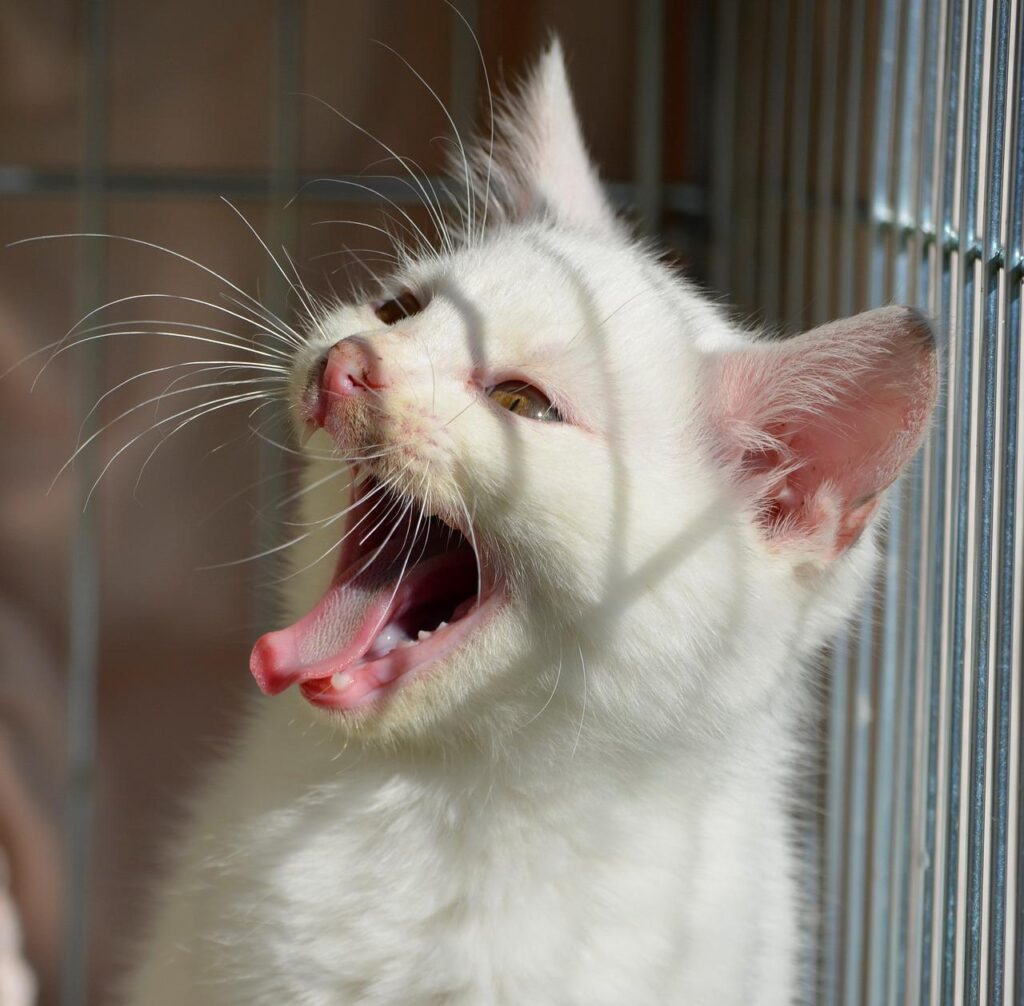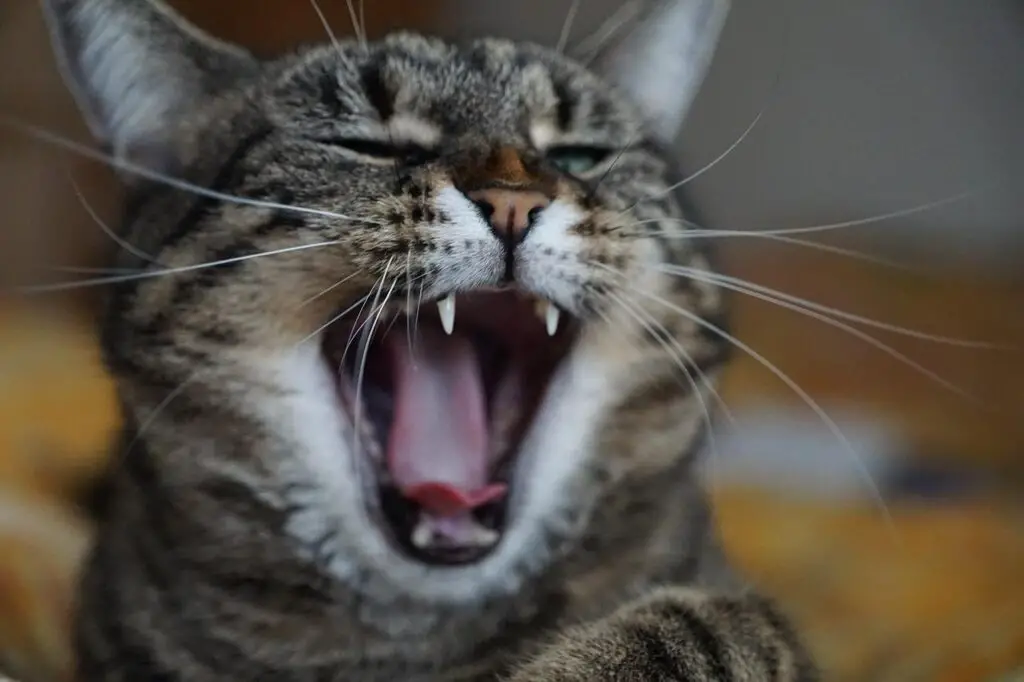You’re not alone if you’re wondering why cats cry on planes.
Stress is a common cause of cats’ crying on planes. Cats can sense when their owners are anxious or stressed, so try to remain calm when traveling with your pet. While air travel can be stressful for both of you, your cat’s stress level can be heightened.
Here are some ways to avoid an emotional rollercoaster with your pet:
The Physiology Of A Cat’s Ears
Cats are known for their sharp hearing, but has anyone ever wondered why cats could be heard crying on planes? It turns out that the physiology of a cat’s ears plays an important role in its discomfort during flight.
A cat’s ear comprises several parts, including three small bones: the malleus, incus, and stapes. These bones vibrate to transmit sound waves from the outer ear to the inner ear, where the brain processes them. The size and shape of these bones make them more sensitive to changes in pressure than human ears. This means that when air pressure drops as a plane ascends or descends, it causes pain in a cat’s ears due to the imbalance between atmospheric pressure inside and outside its eardrum.
Fortunately, this type of pain is temporary and not serious; however, it can still be quite uncomfortable for your feline friend. The good news is there are steps you can take to help alleviate some of this distress while flying with your pet. Providing them with treats like wet food or tuna juice can help distract them from any discomfort they may experience during takeoff or landing. Additionally, ensuring they have plenty of water will prevent dehydration, which often contributes to altitude-related headaches and motion sickness in humans and animals alike!
It’s clear that understanding how high altitudes impact cats’ ears helps us better understand why cats cry on planes – but what about the effects themselves? Let’s delve into that next…

The Impact Of High Altitude On Cat’s Ears
Cats are sensitive creatures with particularly delicate ears. Unsurprisingly, their hearing can be adversely impacted by the high altitude of flying in airplanes. The air pressure changes during a flight, creating a vacuum inside an airplane cabin and causing discomfort for cats’ ears. This change in air pressure affects cats more than other animals because of their inner ear structure’s unique shape and anatomy.
As such, the physical sensation of this sudden shift in air pressure can cause pain in cats’ ears and intense anxiety due to its unfamiliarity. Cats may struggle to regulate their equilibrium when experiencing these disorienting effects caused by flying at high altitudes. Cats often vocalize or cry out due to their distress to cope with this overwhelming feeling.
It’s important to note that while physical factors play an important role in why cats cry on planes, psychological aspects should not be overlooked either. In many cases, fear-based emotions like stress and anxiety manifest themselves through crying, too – making it difficult to separate physiological explanations from psychological ones without further research into individual feline personalities and behaviors.

The Role Of Anxiety In Cat’s Crying On Planes
Anxiety is a common factor in cats crying on planes. Just like humans, cats can experience stress and fear related to flying. After all, being up in the air in an unfamiliar environment can be overwhelming for anyone! To make matters worse, when it comes to felines, their sensitive hearing means they are more likely to pick up on loud noises from engines or turbulence. All of these factors combined increase a cat’s anxiety levels which could lead them to cry out during a flight.
Owners must reduce their pet’s anxiety before boarding the plane. This includes providing them with familiar objects such as toys or blankets that may bring comfort during the journey, limiting treats, so they don’t get over-excited, and getting regular checkups at the vet before traveling. Additionally, using calming products such as pheromones or dietary supplements may help keep your kitty relaxed while onboard.
By taking extra precautions and anticipating your furry friend’s needs, you’ll be better prepared to handle stressful situations throughout their journey – allowing both owner and pet to enjoy a smoother ride without too much worry!
How To Comfort Your Cat On A Plane
Traveling with cats can be stressful, especially when it comes to flying. Surprisingly, according to research by the American Veterinary Medical Association (AVMA), over fifty percent of cats experience some form of crying or vocalization on planes. Therefore, pet owners must understand how to comfort their cats while in flight.
Firstly, various things can help soothe your furry friend during a plane ride. To begin with, providing them with something familiar such as a blanket that smells like home, may ease anxiety levels and promote relaxation. Additionally, including toys they enjoy playing with will keep them occupied throughout the journey and encourage positive behavior. Finally, packing treats you know your cat loves will make them feel special and rewarded after completing the trip.
Moreover, creating an environment where your cat feels secure is also important for successful air travel. It’s best to book flights outside peak hours if possible since this usually leads to less crowded cabins and more space for the kitty to spread out. Also, remember to speak softly to reassure them that everything is okay – this could be through verbal communication or simply stroking their fur gently until calmer times arrive.
These tips should help ensure you and your pets have a pleasant traveling experience together! Consequently, preparing cats for future flights becomes easier as they become accustomed to being away from home in unfamiliar places but still feeling safe alongside their human companion all along the way.
Preparing Cats For Future Flights
Traveling with cats can be a daunting experience, but it doesn’t have to be. With the right preparation and care, you can ensure your cat has a comfortable trip every time they fly. Here’s how to get them ready for future flights.
The first step is to acclimate your cat slowly to its travel crate. This will help reduce their stress levels when boarding an airplane. Allow them some time outside of their box each day so that they become accustomed to it gradually. Offer treats or toys inside the crate so they associate positive things with being in there too!
It’s also essential to familiarize your cat with the airport environment before flying. Bring them on visits beforehand so they know what to expect – this could include car rides, waiting in line, and going through security checks. The more relaxed your cat is during these steps, the better prepared they’ll be for take-off and landing.
Finally, pack plenty of snacks, toys, and bedding for comfort during long trips. Familiar items such as blankets or soft pillows might help ease anxiety around unfamiliar noise or movement on planes. And don’t forget extra water bowls – dehydration can cause additional distress for cats onboard aircraft too! All these precautions will ensure your furry friend enjoys flying as much as you do!
Sedatives Help Cats Relax on Planes
If you want to make traveling a pleasant experience for your cat, there are some sedatives to ease the stress and anxiety caused by the flight. Cat sedatives are often taken orally, but there are also medications that veterinarians can prescribe.
These medications are more potent than over-the-counter sedatives, so veterinarians may want to consider prescribing them when necessary. Sedatives are generally safe for cats that are in good health.
Some sedatives for cats are made from natural ingredients. Valerian is a perennial flowering herb native to Asia and Europe. The herb’s root has long been a sedative and promotes exercise and play behavior.
When fed to a cat half an hour before the flight, Valerian can help the feline traveler unwind and sleep peacefully. However, sedatives for cats have their drawbacks, and the International Air Transport Association (IATA) strongly discourages using these medications before a flight.
Taking sedatives for your cat will make the experience more stressful and disturb their routine. So, while taking a sedative for a cat is not a bad idea, it’s important to remember that not all sedatives work for all cats.
Frequently Asked Questions
Conclusion
Flying with cats can be stressful, but it doesn’t have to be. With some preparation and understanding of your pet’s needs, you can make the experience much more enjoyable for everyone involved.
First, take time to familiarize yourself with the airline’s policies regarding pets. Make sure that they meet all safety requirements before booking tickets. Please keep them in a carrier during takeoff and landing so they feel secure. Additionally, bring along toys or treats to help distract them from any potential stressors while on board.
Finally, remember that cats express their emotions differently than humans – usually through vocalization rather than facial expressions. When your cat cries on planes, don’t panic; look out for signs of pain or fear and adjust accordingly. By taking these steps, you’ll ensure you and your furry friend have a safe and comfortable journey!



